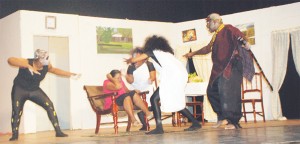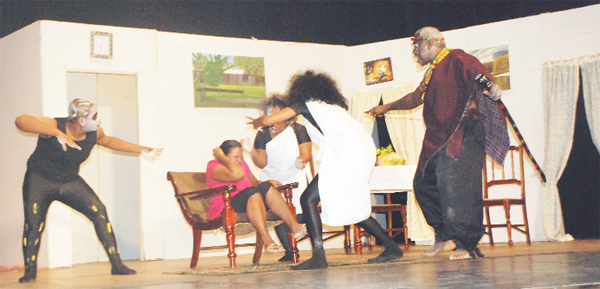The past haunts the present in The Legend of the Silk Cotton Tree, Guyana’s signal dramatic presentation which premiered on Friday evening, at the National Cultural Centre.

Featuring a cast of stage veterans alongside new discoveries, the play enthralled a capacity crowd that was on hand to witness the rebirth of Guyanese theatre. The drama, an exploration of the role of Guyanese folklore in the shaping of the country’s history, is a new play written for Carifesta X. It is not a perfect beginning — in fact, far from it — but as the first brick in the new foundation of local drama it can be seen as a promising start.
The play is based on a concept by Barrington Braithwaite and was written for the stage and directed by Al Creighton. It is set in the ancient county, Berbice, and tells the story of Elsa (Sonia Yarde), an expectant mother who suddenly finds herself troubled by powerful nightmares, which are believed to have been inspired by her mysterious connection to the Silk Cotton Tree and the ancestral spirits that still dwell within it. The dreams, which grow more real to Elsa with every recurrence, become a source of worry for her family and friends, including her husband Hubert (Neaz Subhan), her father Victor (Lionel Whyte) and a village ‘uncle’ Imran (Richard Narine).
The narrative serves as a vehicle for an examination of the legends and myths that form part of Guyana’s folklore and how they still bear a great significance to modern life. The past continually intrudes and the action shifts from present-day Berbice to the 18th century Dutch plantations, where slaves launched their first major bid for freedom in the Caribbean — the 1763 Berbice Slave uprising. The main objective of the play is twofold: First, there is the importance of preserving history, embracing both the good and the bad.
“This a yuh heritage,” says Olum, the Obeahman (Godfrey Naughton), who stalks Elsa in her dreams. (He is a dangerous antagonist, but the narrative also situates him as a victim of colonialism and in particular the ambitions of a Dutch planter Van Shrecken [Ron Robinson in his best British accent].)
Secondly, there is the idea of using the lessons learned from the past to navigate the uncertain seas of the future. As another character puts it: “Knowledge is power; ignorance leaves you unprotected.”
The acting had its highs and lows: Yarde has been a staple on the local theatre circuit for more than a decade. She has a reputation as a reliable actress and she did not disappoint; Narine is also a reliable actor and he occupied the character with just the right amount of nuance; Subhan stumbled initially, forgetting his lines, and while he quickly recovered he hardly injected any feeling into the part; Naughton, meanwhile, was undoubtedly the scene stealer, using his towering figure and booming voice to walk the stage with the appropriate amount of menace.
Ultimately, the play was overwrought. The combination of drama, dance, and music was seamless and did not disturb the unity of the action, though the playwright’s fascination with history seemed to stifle the progression of the narrative, resulting in scenes laden with exposition that dragged on and on. Not surprisingly, this was also brought to bear on the dialogue, which, apart from a few instances of real excitement, was mundane and lifeless, often veering into cliché.
To the play’s credit, however, the audience was appreciative and continually cheered after every scene.
Nevertheless, the woman next to me fell asleep at regular intervals. Afterward, she declared, “It too long.
Too much talking.”
Not exactly an academic critique, but it succinctly captured the prevailing mood among the people. Surely, a serious play does not have to be a snore. “This generation can do with some shaking up,” says Imran, near the end of the play. Whether or not The Legend of the Silk Cotton Tree will be doing the shaking, time will tell.

